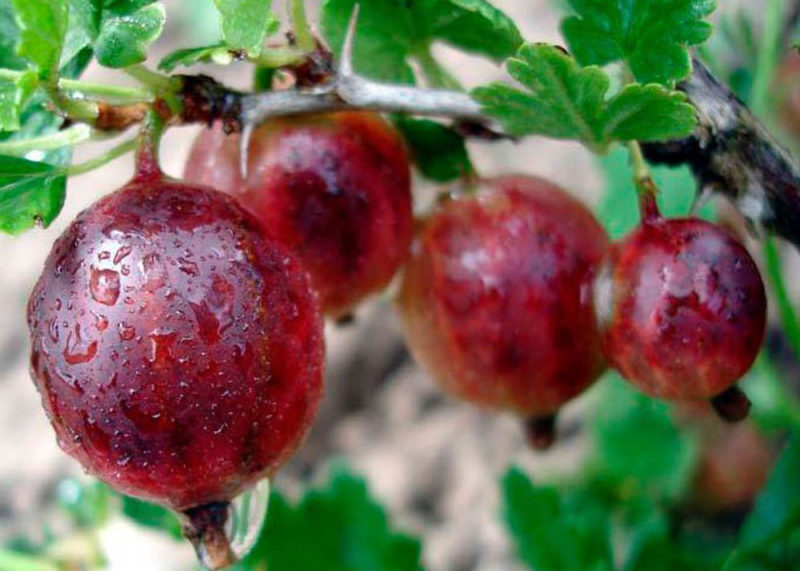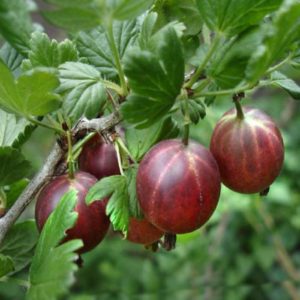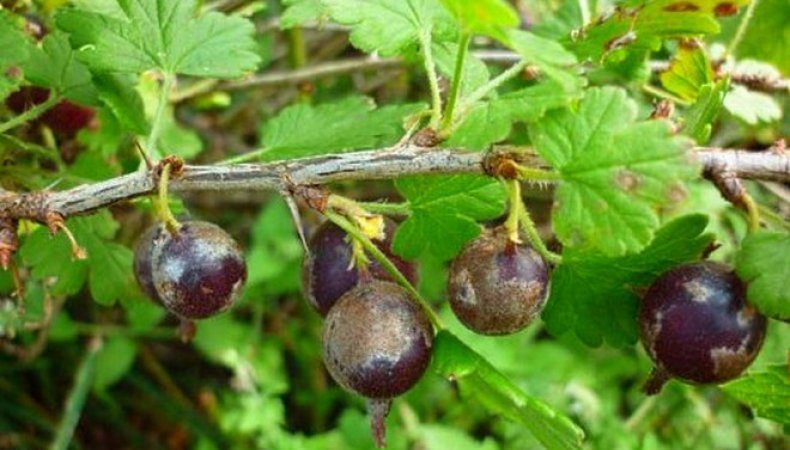High-yielding gooseberry variety with dark red fruits "Russian"
The Gooseberry family (Grossulariaceae) contains about 160 species, differing in taste and fruit size, yield, resistance to disease and drought. All these characteristics, as well as the climatic conditions of the area, are taken into account when choosing a gooseberry for planting. One of the popular varieties is Russian, with dark red fruits, a reliable and fruitful gooseberry with strong immunity and good winter hardiness.
The content of the article
Gooseberry Russian
The medium-late ripening gooseberry variety Russian red was created in the 50s of the last century at the V.I. I. V. Michurin. It was obtained by pollination of the Careless variety with a mixture of pollen collected from Oregon, Houghton, Curry and Shtambovoy.
The creator of the variety is K.D.Sergeeva. Since 1959, Russian has been included in the State Register of Breeding Developments and is recommended for use in almost all regions, except for the Urals.

Characteristics and description of the bushes
The culture grows to an average of 1.5-1.8 m in height. Young shrubs are spreading, with a crown of medium density, weak branching, become compact by mature age. Stems are thick, arcuate, not pubescent in the upper part.
Lignified branches of medium thickness, light. The spike level is medium, rising towards the bottom of the bush. Straight and light spines are located perpendicular to the shoot or obliquely upward.
Gooseberry leaves small, green in color, dull or slightly glossy, with 5 lobes. The petioles of the leaf blades are of medium length and thickness.
Resistant to temperatures
The Russian variety belongs to frost-resistant crops, but experienced gardeners recommend protecting the plant in case of a snowless winter and early frosts. The bushes are insulated by mulching the periosteal circle with horse humus.
Moisture and drought resistance
The gooseberry is considered a drought tolerant crop due to its deeply penetrating root system. This saves him in dry weather, if watering is not carried out.
The bush does not tolerate excessive regular watering - they can provoke rot.
Disease and pest resistance
The culture is characterized by strong immunity, stable to powdery mildew and septoria.
Characteristics and description of fruits

After flowering on the branches, brushes with one or two berriescovered with a waxy bloom. The weight of delicate and fragrant fruits ranges from 3-6 g, the shape is oval or elliptical, the skin is of medium thickness, not pubescent, the taste is sweet and sour, is estimated at 4.0-4.4 points. During the ripening period, the fruits are dark red, along the berries are pronounced pink veins.
Ripe berries hang for a long time and do not crumble. Chemical composition per 100 g of gooseberries:
- sugar - 9.9%;
- titratable acidity - 1.8%;
- ascorbic acid - 23.6-41.6 mg.
Areas of use
Thanks to its beneficial properties, gooseberries are used in different directions.
In folk medicine
A decoction of the fruit is used as a laxative.Fresh berries, on the contrary, help with diarrhea, as well as to relieve the symptoms of osteochondrosis and arthritis.
Regular consumption of gooseberries replenishes vitamin deficiencies, improves metabolism, strengthens the immune and cardiovascular systems.
In cosmetology
The fruits are used for whitening and improving complexion, against hair loss.
In dietary nutrition
Gooseberries are a low-calorie product: 100 g of fresh berries contain only 44 kcal. The use of fruits promotes better assimilation of proteins, accelerates metabolic processes, and increases the body's ability to burn calories.
In cooking
Fleshy sweet and sour fruits and freshly picked leaves are added to salads from fruits and vegetables. Jams, marmalade, compotes, wine, juices, sauces are made from gooseberries, added to baked goods, ice cream, smoothies. Red gooseberries are combined with vegetable and meat dishes.
Advantages and disadvantages compared to other varieties and hybrids

Summer residents, who have already managed to evaluate the quality of the Russian variety, distinguish it from others according to the following characteristics:
- high yields for 15 years;
- easy growing;
- immunity to disease;
- drought and frost resistance;
- self-fertility;
- versatility of fruit use;
- high commercial and consumer qualities.
The disadvantages of this culture, experts refer to the spreading of the bush at a young age.
Growing technology
To get a highly productive culture, a suitable place is selected for it, planting rules are followed, and regular care is taken.
Optimal conditions
The plant is light-loving, it is planted in areas that are lighted and protected from drafts. In the shadows are significantly reduced yield and the quality of the fruit.
The gooseberry prefers loose and fertile soil with a neutral or slightly acidic reaction. It grows poorly in flooded areas, therefore, when planting, pay attention to the groundwater level (at least 1.5 m from the surface).
The shrub bears fruit every year, the land is extremely depleted, so gooseberries need regular feeding.
Terms and rules of landing

The Russian variety is planted in late September - mid-October, depending on the climate, a month before the first frost. The root system grows at a daytime temperature of + 10 ... + 15 ° С. With premature minus values, planting is postponed until spring. The advantage of spring planting is that the bushes develop without the risk of freezing.
Work order:
- Dig a hole 50 × 50 cm.
- Drainage and a layer of loose fertile soil are laid.
- The seedling is cut in half or ⅔, the roots are trimmed and set in the hole at a slight angle.
- After planting, watered abundantly.
If several bushes are planted, a distance of at least 1.5 m is observed between the holes.
Further care
At different stages of development, the plant's need for moisture changes. Increase the amount of watering:
- in spring, during the active growing season of the plant;
- after flowering during fruit formation;
- after harvest.
In the rainy season, the crop does not need watering, but the lack of moisture in the heat reduces the yield.
In early spring, nitrogen-containing substances are introduced to promote shoot growth. The next time they are fed before flowering with potash fertilizers. After flowering and harvesting, organic matter is introduced.
Important! Fertilizers are applied under the root in moist soil so that the roots do not burn out.
Once a year, in spring or autumn, dry and damaged branches are removed. Pruning is carried out at soil level so that no hemp remains.
Weeds are removed in a timely manner so that the plants have enough nutrients, light, moisture, as well as to prevent development diseases and attacks of harmful insects.
Possible problems, diseases, pests

Although the culture is resistant to some diseases, if the planting technology is violated or poor-quality care, gooseberry bushes are threatened:
- Anthracnose. Small brown blotches appear on the leaves, which, growing, lead to wilting and falling of the leaves. Prevention consists in the use of preparations containing copper.
- Mosaic. Light yellow spots are visible along the veins of the leaves. The leaf plate becomes smaller and wrinkles. A viral disease cannot be cured - the bushes are uprooted and burned. Plant immunity is increased by fertilizing several times per season.
- Aphid. Pest weakens the plant by feeding on the sap of the leaves. To combat it, folk remedies are used: garlic infusion, soap solution. If there are too many insects, use insecticides "Fufanon", "Aktara".
Wintering
Shelter is necessary only for young seedlings. In order for the bush to safely endure the winter, after harvesting it is fertilized, watered in late autumn. With the arrival of cold weather, the trunk circle is mulched with horse humus.
Reproduction
The gooseberry is propagated vegetatively: by layering, dividing the bush, green and lignified cuttings. Seed propagation is used to develop new varieties. In most cases, red gooseberries are propagated by rooting cuttings - individual branches on a mother bush - and then growing them in a nursery.
Features of cultivation depending on the region
The frost resistance of the variety allows it to be cultivated in almost all regions, with the exception of the Ural region. Russian gooseberry is very popular with summer residents in the Moscow region.
Pollinating varieties
The culture is self-fertile, quickly begins to bear fruit and does not need pollinating varieties. However, experienced gardeners recommend planting several varieties on the site to increase the yield - Plum, Russian, Pink 2. At the same time, the berries become tastier and larger.
Gardeners reviews
Experienced gardeners leave positive reviews about the Russian red gooseberry and share their recommendations.
Tatiana, Oktyabrsk: “I have long wanted to plant a gooseberry with large berries, I planted Russian red and was not mistaken. The shrub is unpretentious, not affected by powdery mildew, and the berries grow tasty and large. My bushes are already 5 years old, I have not made a replacement yet, the yield remains at the same level, except that over the years the size of the berries has decreased due to their abundance. To return to its previous size, I replaced the old crown with a new one from a young shoot. "
Vitaly, Mytischi: “For a long time I did not dare to cut the gooseberry branches, which were bent to the ground under the weight of large red berries. It turns out that they also need to be removed. From this, the Russian gooseberry rejuvenates and brings a much larger harvest next season. I was convinced by my own experience ".
Conclusion
The gooseberry variety Russian red has been tested by time - it has been popular for over 60 years thanks to its delicious sweet and sour berries, winter hardiness, and easy care. Applying knowledge of the basic rules of growing a crop, it is easy to get consistently high yields of fragrant fruits.